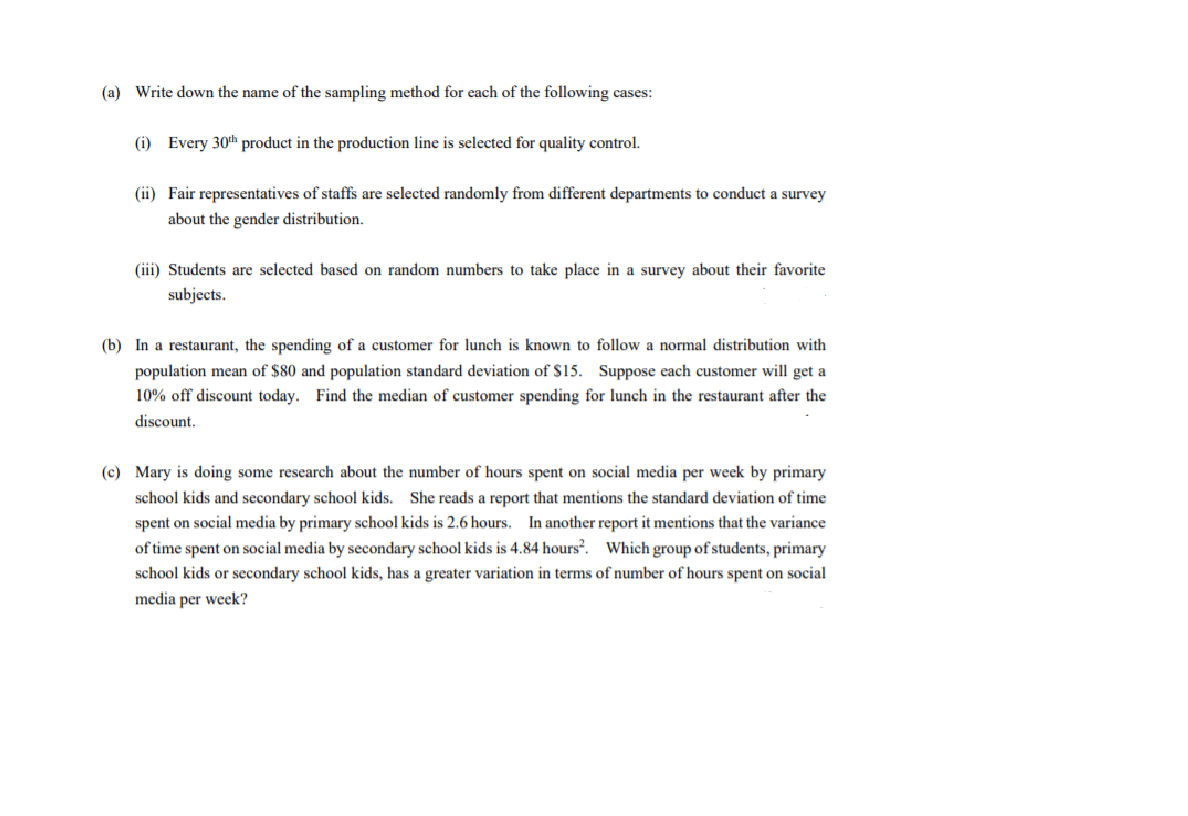(b) In a restaurant, the spending of a customer for lunch is known to follow a normal distribution with population mean of $80 and population standard deviation of $15. Suppose each customer will get a 10% off discount today. Find the median of customer spending for lunch in the restaurant after the discount. (c) Mary is doing some research about the number of hours spent on social media per week by primary school kids and secondary school kids. She reads a report that mentions the standard deviation of time spent on social media by primary school kids is 2.6 hours. In another report it mentions that the variance of time spent on social media by secondary school kids is 4.84 hours². Which group of students, primary school kids or secondary school kids, has a greater variation in terms of number of hours spent on social media per week?
(b) In a restaurant, the spending of a customer for lunch is known to follow a normal distribution with population mean of $80 and population standard deviation of $15. Suppose each customer will get a 10% off discount today. Find the median of customer spending for lunch in the restaurant after the discount. (c) Mary is doing some research about the number of hours spent on social media per week by primary school kids and secondary school kids. She reads a report that mentions the standard deviation of time spent on social media by primary school kids is 2.6 hours. In another report it mentions that the variance of time spent on social media by secondary school kids is 4.84 hours². Which group of students, primary school kids or secondary school kids, has a greater variation in terms of number of hours spent on social media per week?
Holt Mcdougal Larson Pre-algebra: Student Edition 2012
1st Edition
ISBN:9780547587776
Author:HOLT MCDOUGAL
Publisher:HOLT MCDOUGAL
Chapter11: Data Analysis And Probability
Section11.4: Collecting Data
Problem 2E
Related questions
Question
just do part b) and part c)

Transcribed Image Text:(a) Write down the name of the sampling method for each of the following cases:
(i) Every 30th product in the production line is selected for quality control.
(ii) Fair representatives of staffs are selected randomly from different departments to conduct a survey
about the gender distribution.
(iii) Students are selected based on random numbers to take place in a survey about their favorite
subjects.
(b) In a restaurant, the spending of a customer for lunch is known to follow a normal distribution with
population mean of $80 and population standard deviation of $15. Suppose each customer will get a
10% off discount today. Find the median of customer spending for lunch in the restaurant after the
discount.
(c) Mary is doing some research about the number of hours spent on social media per week by primary
school kids and secondary school kids. She reads a report that mentions the standard deviation of time
spent on social media by primary school kids is 2.6 hours. In another report it mentions that the variance
of time spent on social media by secondary school kids is 4.84 hours?. Which group of students, primary
school kids or secondary school kids, has a greater variation in terms of number of hours spent on social
media per week?
Expert Solution
This question has been solved!
Explore an expertly crafted, step-by-step solution for a thorough understanding of key concepts.
Step by step
Solved in 3 steps

Recommended textbooks for you

Holt Mcdougal Larson Pre-algebra: Student Edition…
Algebra
ISBN:
9780547587776
Author:
HOLT MCDOUGAL
Publisher:
HOLT MCDOUGAL

College Algebra (MindTap Course List)
Algebra
ISBN:
9781305652231
Author:
R. David Gustafson, Jeff Hughes
Publisher:
Cengage Learning

Holt Mcdougal Larson Pre-algebra: Student Edition…
Algebra
ISBN:
9780547587776
Author:
HOLT MCDOUGAL
Publisher:
HOLT MCDOUGAL

College Algebra (MindTap Course List)
Algebra
ISBN:
9781305652231
Author:
R. David Gustafson, Jeff Hughes
Publisher:
Cengage Learning